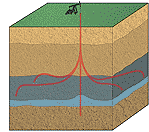
Reservoir
Applications
Lateral well branches increase productivity and injectivity, and improve hydrocarbon
recovery by maximizing reservoir contact. Multilateral wells can tap bypassed
reserves by producing from more than one formation
or reservoir.
with heavy-oil reserves; low permeability or natural fractures; laminated or layered zones; and bypassed hydrocarbons in distinct structural or stratigraphic compartments; it also facilitates development of small outlying, or satellite, fields. [note 4]
Multilateral wells can exploit low-pressure or depleted reservoirs and improve infill or reentry drilling by targeting areas that are uneconomic to produce with dedicated wellbores. [note 5] Lateral branches from existing wells can tap additional reserves without abandoning current production, allowing continued production from mature reservoirs.
Multiple well branches help modify reservoir drainage in tertiary water- or steam-injection projects. Laterals from existing wells can improve inflow and realign flood patterns as sweep efficiency changes over time.
Multilateral wells assist with reservoir conformance. Variable lateral lengths in different reservoir intervals can improve vertical sweep and recovery. Horizontal laterals mitigate gas and water coning in some reservoirs, especially those with thin oil zones, gas caps or bottom-waterdrive. Multilateral wells also improve recovery during gas-cap depressurization and improve deliverability from gas-storage projects. [note 6]
Reservoir delineation is another role for multilateral wells, which can sample horizontal reservoir quality and probe areal extent with two or more laterals from a single surface location. In addition, successive laterals can be planned based on knowledge gained from drilling the main borehole and preceding laterals.
| Previous | Continue to The Future: Increasing Acceptance |
|
|
